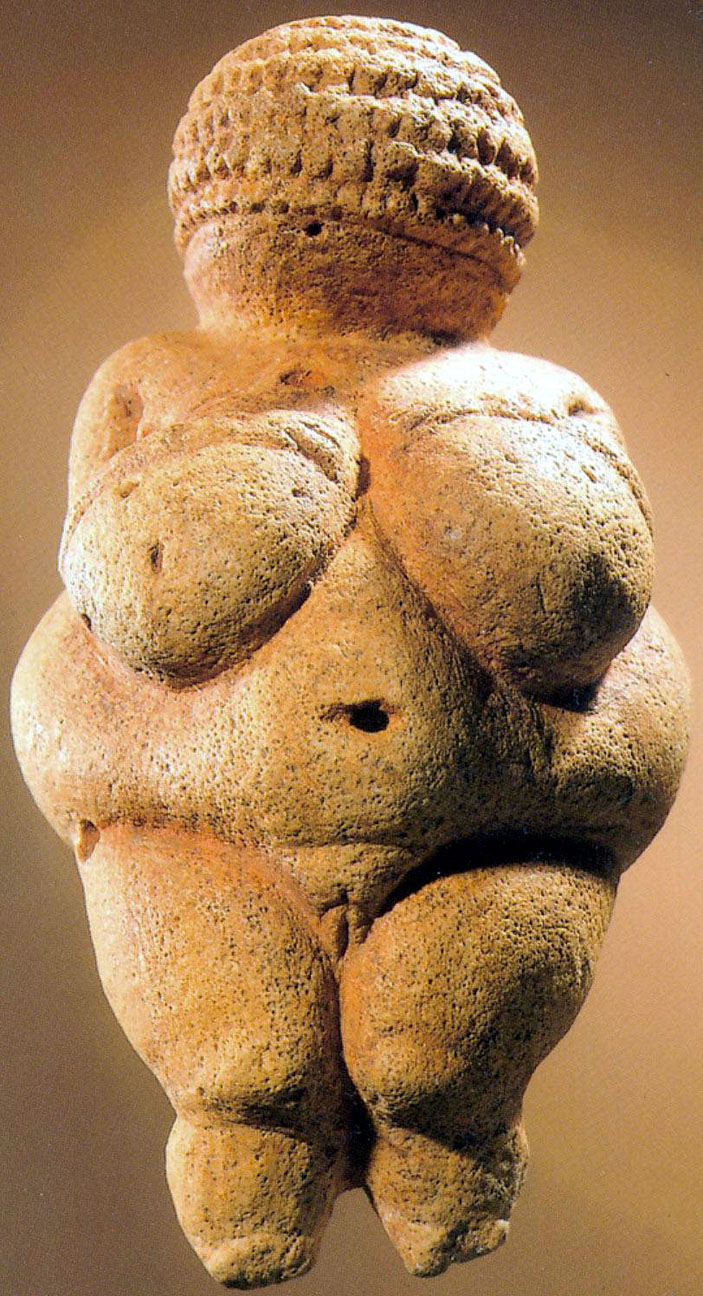
Identification |
|
Title : Woman of Willendorf
Date : 22,000 - 21,000 BCE
Medium : Limestone
Culture : Paleolithic
Significance : Women were frequent subjects in prehistoric art. Possibly a fertility statue. Or worship of women.
|
| |
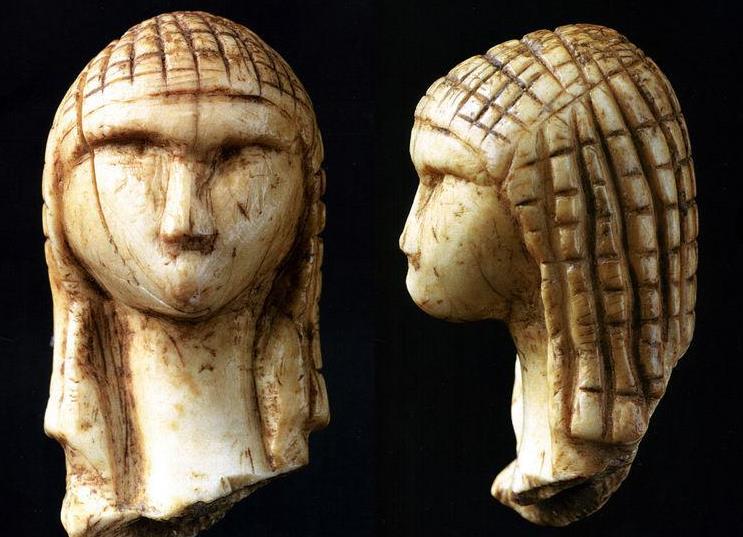
Identification |
|
Title : Woman from Brassempouy
Date : ca. 22,000 BCE
Medium : Ivory
Culture : Paleolithic
Significance: Possibly a fertility statue.
|
| |
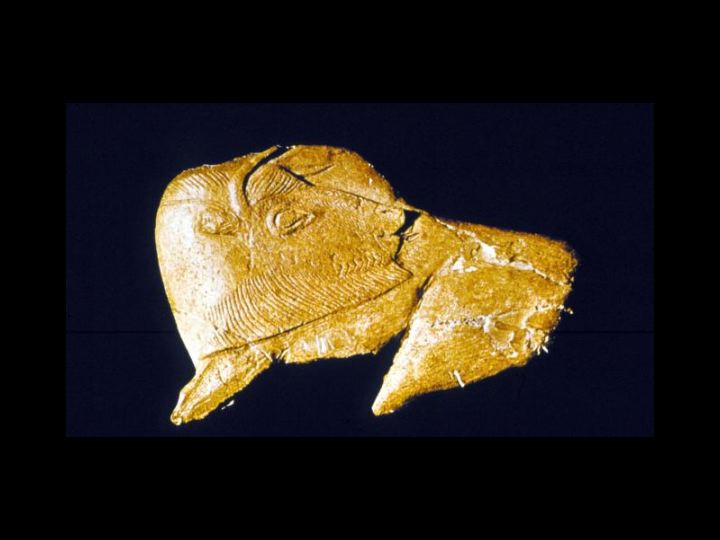
Identification |
|
Title : Bison Horn
Date : 15,000 - 10,000 BCE
Medium : reindeer antler
Culture: Paleolithic
Significance: A fragmentary spear thrower
|
| |
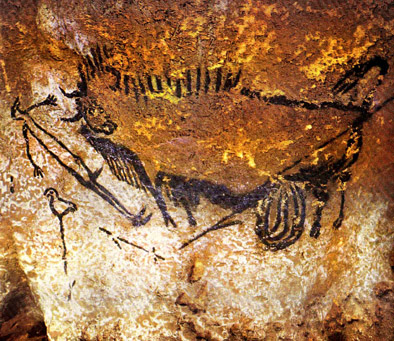
Identification |
|
Title : Bird Headed Shaman
Date : 15,000 - 12,000 BCE
Medium : Paint Limestone
Culture : Paleolithic
Significance : Earliest Human depicted visually.
|
| |
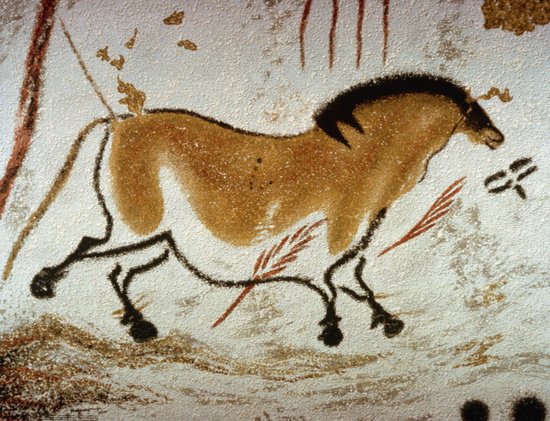
Identification |
|
Title : Chinese Horse
Date : 15,000 - 12,000 BCE
Medium : Cave Wall
Culture : Paleolithic
Significance : Displays the painters acute power of observation. The act of painting the image might have served some ritual or religious purpose. Sympathetic magic
|
| |
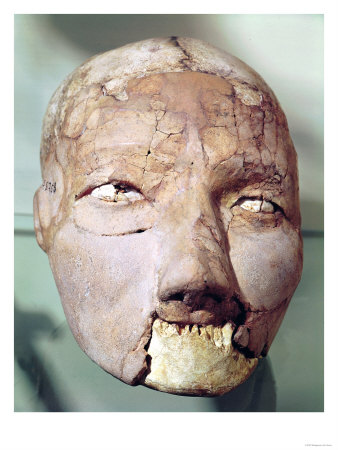
Identification |
|
Title : Plastered Skull
Date : ca. 7000 BCE
Medium : Plaster over human bone
Culture : Neolithic
Significance : Found in Jericho. Heads of the deceased were displayed in the homes. A funerary practice suggesting respect for ancestors and the dead.
|
| |
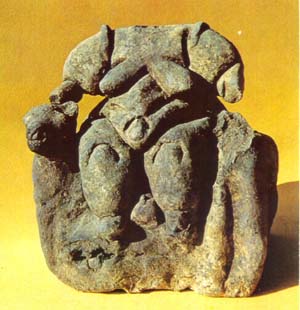
Identification |
|
Title : Seated Goddess
Date: ca. 6500 - 5500 BCE
Medium :
Culture : Neolithic
Significance :
|
| |
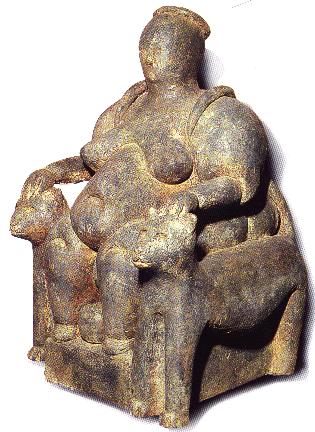
Identification |
|
Title : Female Figure
Date: ca. 6500 - 5500 BCE
Medium : baked clay
Culture : Neolithic
Significance :
|
| |
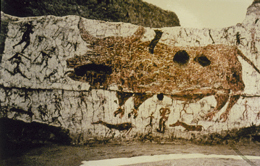
Identification |
|
Title : Bull Hunt
Date : ca. 6500 - 5500 BCE
Medium : Wall painting
Culture : Neolithic
Significance : transition from animals alone to humans
dominating animals (paleolithic to neolithic) |
| |
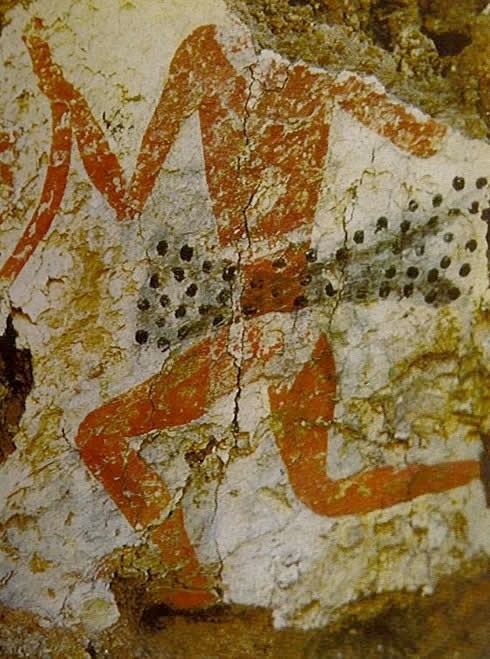
Identification |
|
Title : Dancing Hunter
Date : ca. 6500 - 5500 BCE
Medium : Wall painting
Culture : Neolithic
Significance :
|
| |
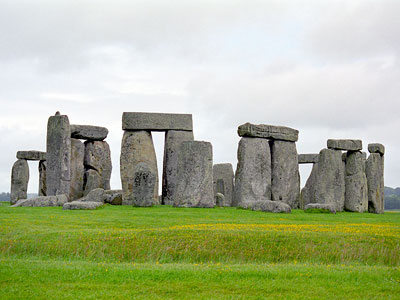
Identification |
|
Title : Stonehenge
Date : 2750 - 1500 BCE
Medium : Stone Megaliths
Culture : Neolithic
Significance : Possibly a calendar. Represents tremendous manpower, organization, and engineering skill.
|
| |
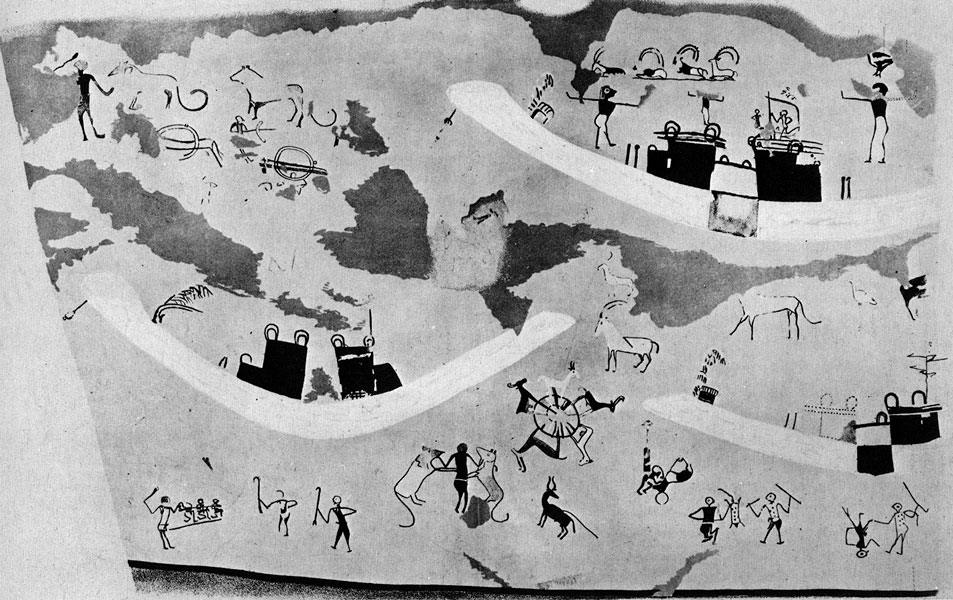
Identification |
|
Title : Wall Painting Showing Boats
Date : ca. 3500 - 3400 BCE
Medium : Tomb Painting
Culture : Predynastic Egpyt
Significance : Funerary Art
|
| |
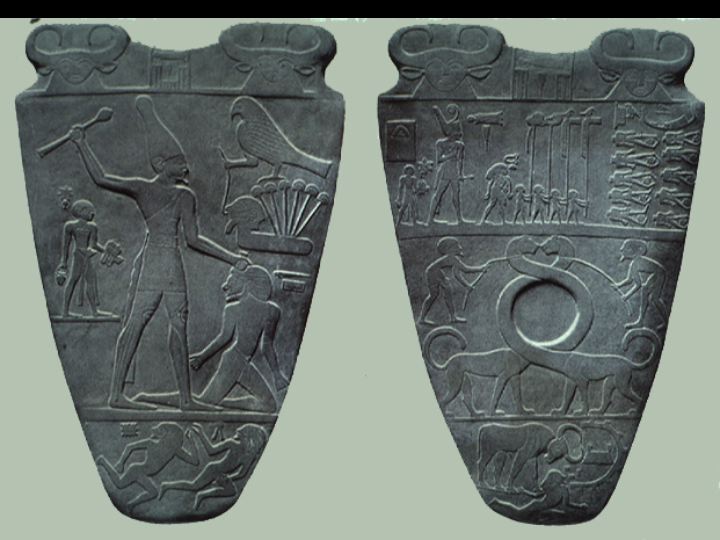
Identification |
|
Title : Palette of Narmer
Date : ca. 3150 - 3125 BCE
Medium : Slate
Culture : Early Dynastic Egypt
Significance : Ritual palette used for cosmetics.
Tells the story of the unification of upper and lower Egypt by King Narmer. |
| |
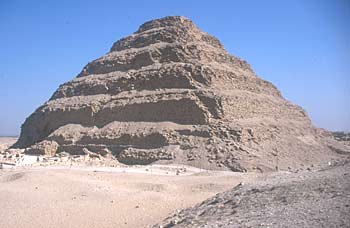
Identification |
|
Title : Step Pyramid of King Djoser
Date : 2681 - 2662 BCE
Medium : Limestone
Culture : Old Kingdom Egypt
Significance : III Dynasty First known major funerary complex
|
| |
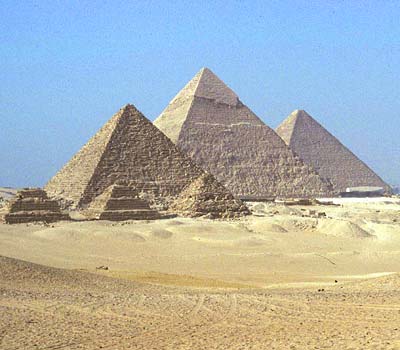
Identification |
|
Title : Great Pyramids of Giza
Date : 2601 - 2515 BCE
Medium : Granite and Limestone, covered in gold
Culture : Old Kingdom Egypt
Significance : Created to commemorate King Sneferu's sons Khufu, Khafra, and Menkaure. IV dynasty Pyramids reach upwards toward the sky easing the transition to the Gods
|
| |
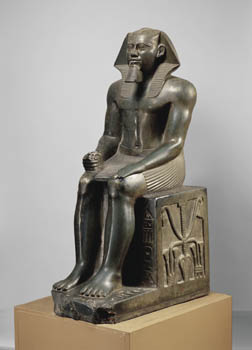
Identification |
|
Title : Seated Khafra
Date : ca. 2570 - 2544
Medium : Diorite
Culture : Old Kingdom Egypt
Significance : Funerary art used to house the life force or Ka of the individual.
|
| |
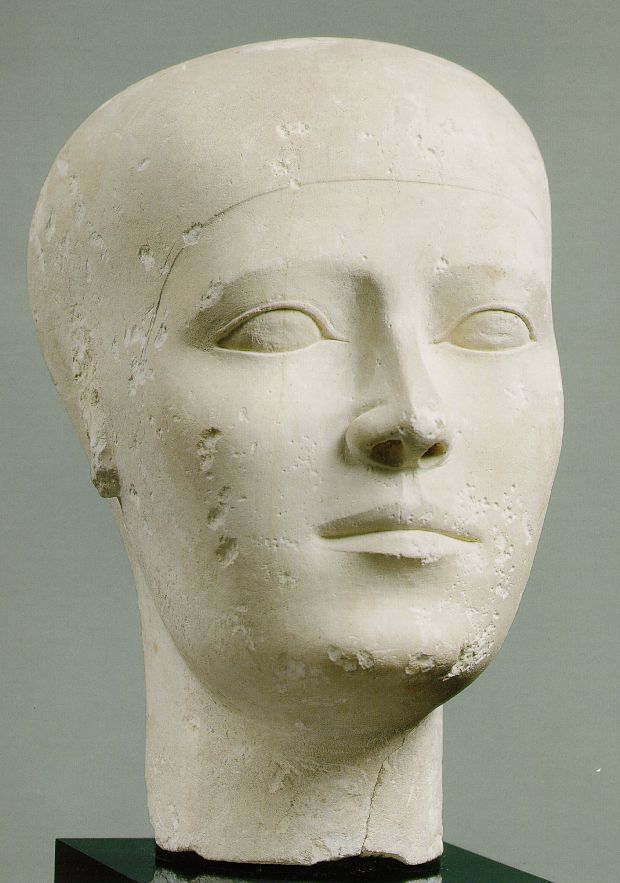
Identification |
|
Title : Reserve Head
Date : ca. 2550 BCE
Medium : Limestone
Culture : Old Kingdom Egypt
Significance :
|
| |
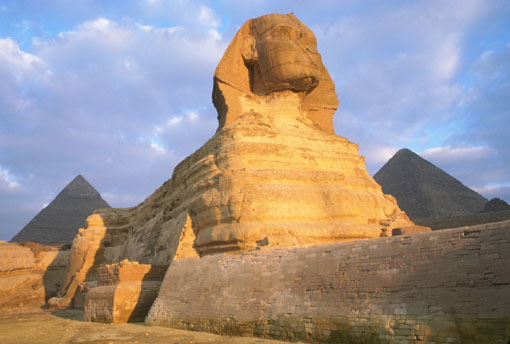
Identification |
|
Title : Great Sphinx
Date : 2570 -2544 BCE
Medium : Sandstone
Culture : Old Kingdom Egypt
Significance:
|
| |
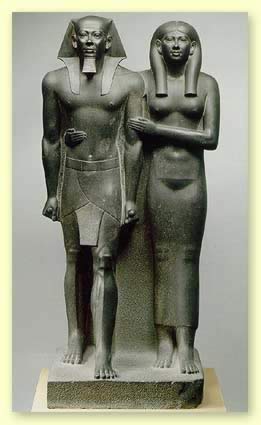
Identification |
|
Title : Menkaure and his wife
Date : ca. 2515 BCE
Medium : Slate
Culture : Old Kingdom Egypt
Significance : Menkaure and his wife are about the same height and similarity in pose which establishes the appearance of unity.
|
| |
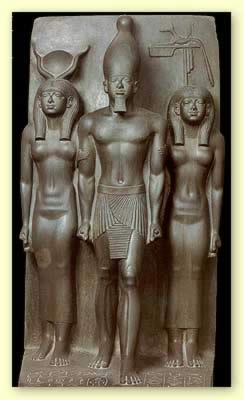
Identification |
|
Title : Menkaure between Hathor and Local Deity
Date : 2470 BCE
Medium :
Culture : Old Kingdom Egypt
Significance :
|
| |
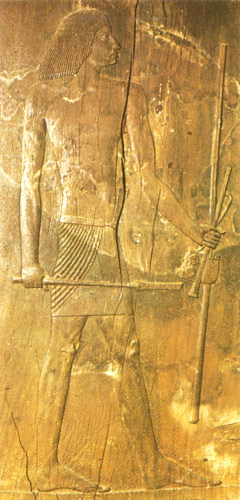
Identification |
|
Title : Hesy-ra
Date : ca. 2650 BCE
Medium : Wood
Culture : Old Kingdom Egypt
Significance : Elite officials were depicted in two kinds of ideal images. The youthful and the mature. This is a depiction of the youthful stage in life.
|
| |
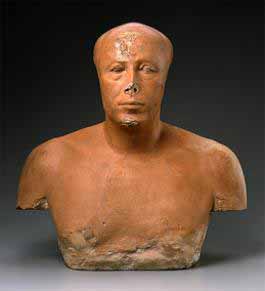
Identification |
|
Title : Prince Ank-haf
Date : ca. 2600 BCE
Medium :
Culture : Old Kingdom Egypt
Significance :
|
| |
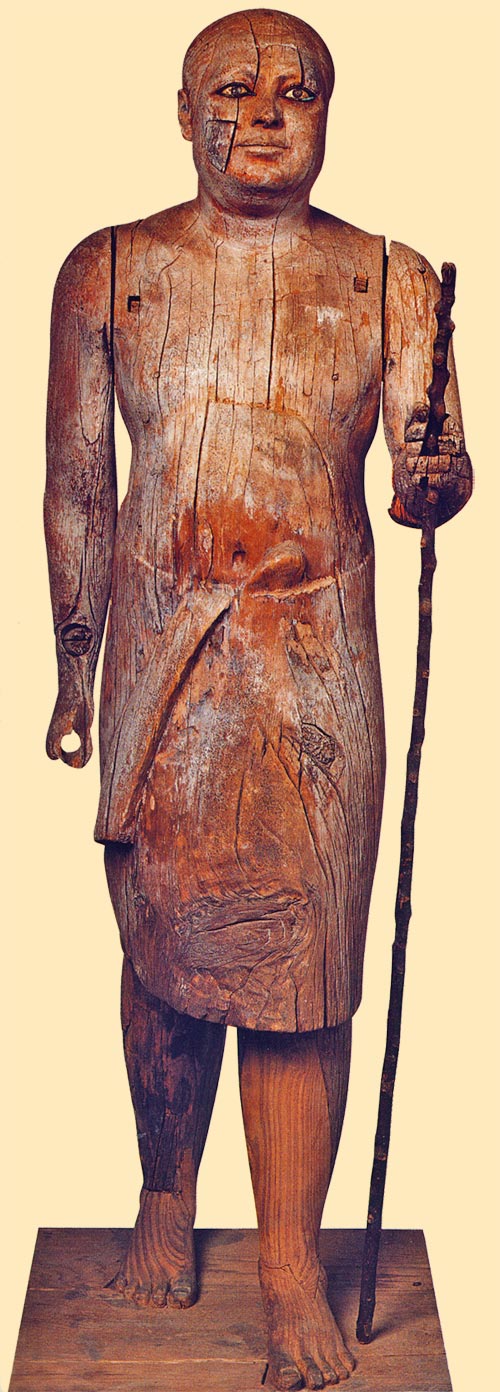
Identification |
|
Title : Sheik el Beled
Date : ca. 2500 BCE
Medium : Wood
Culture : Old Kingdom Egypt
Significance : His round figure and old appearance shows his higher more comfortable status in egyptian society. Depiction is more naturalistic.
|
| |
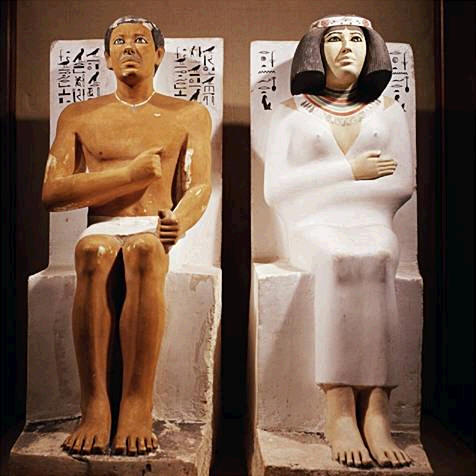
Identification |
|
Title : Prince Rahotep and his wife Nofret
Date : ca. 2160 BCE
Medium : Painted Limestone
Culture : Old Kingdom Egypt
Significance : A more naturalistic appearance.
|
| |
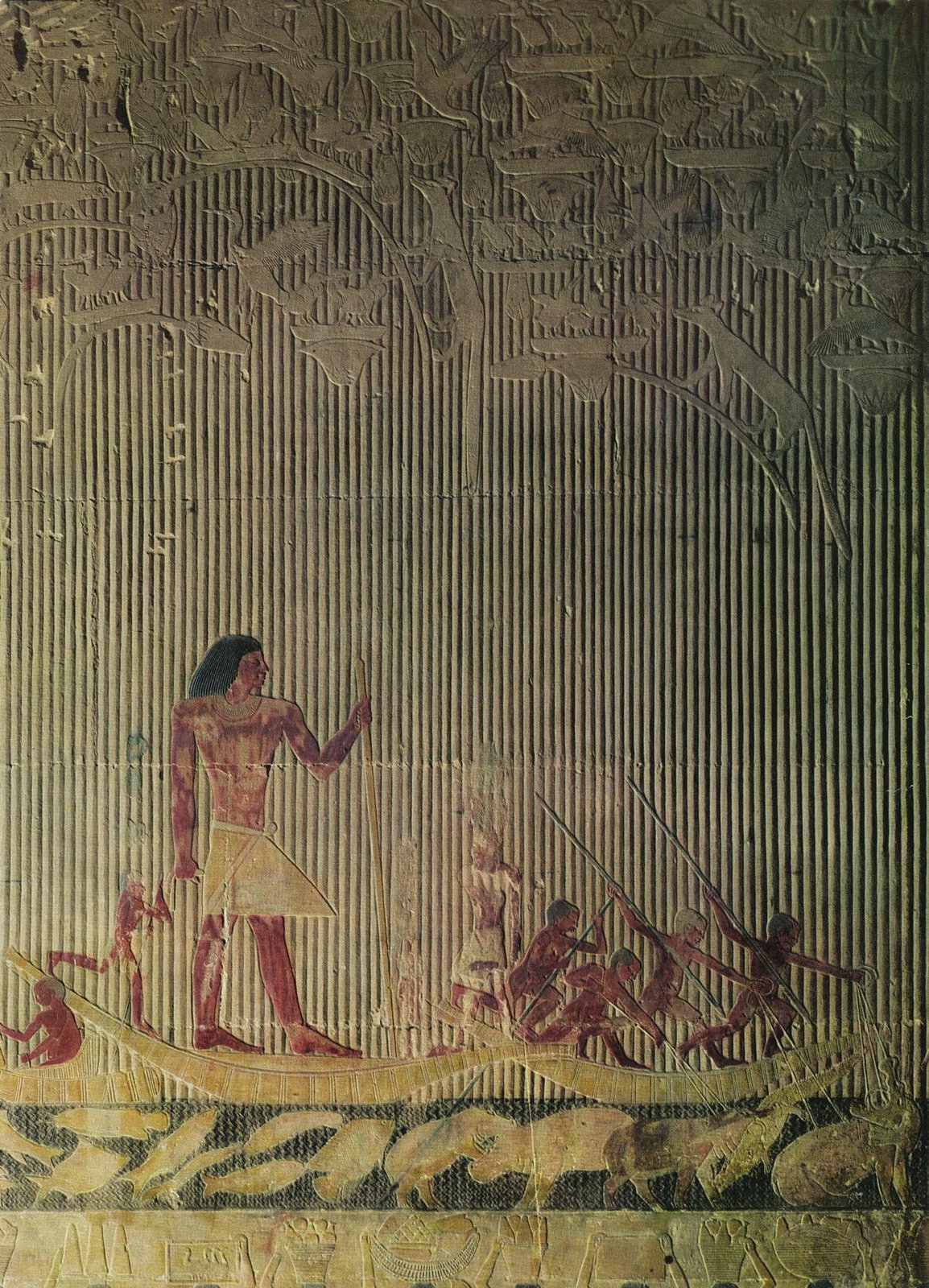
Identification |
|
Title : Ti watching a Hippopotamus Hunt
Date : ca. 2150 -2460 BCE
Medium : Painted Limestone
Culture : Old Kingdom Egypt
Significance : Funerary art depicting a leisurely activity for the deceased to take part in in the afterlife. Boats were the vehicle that carried the Ka through it's eternal journey in the afterlife.
|
| |
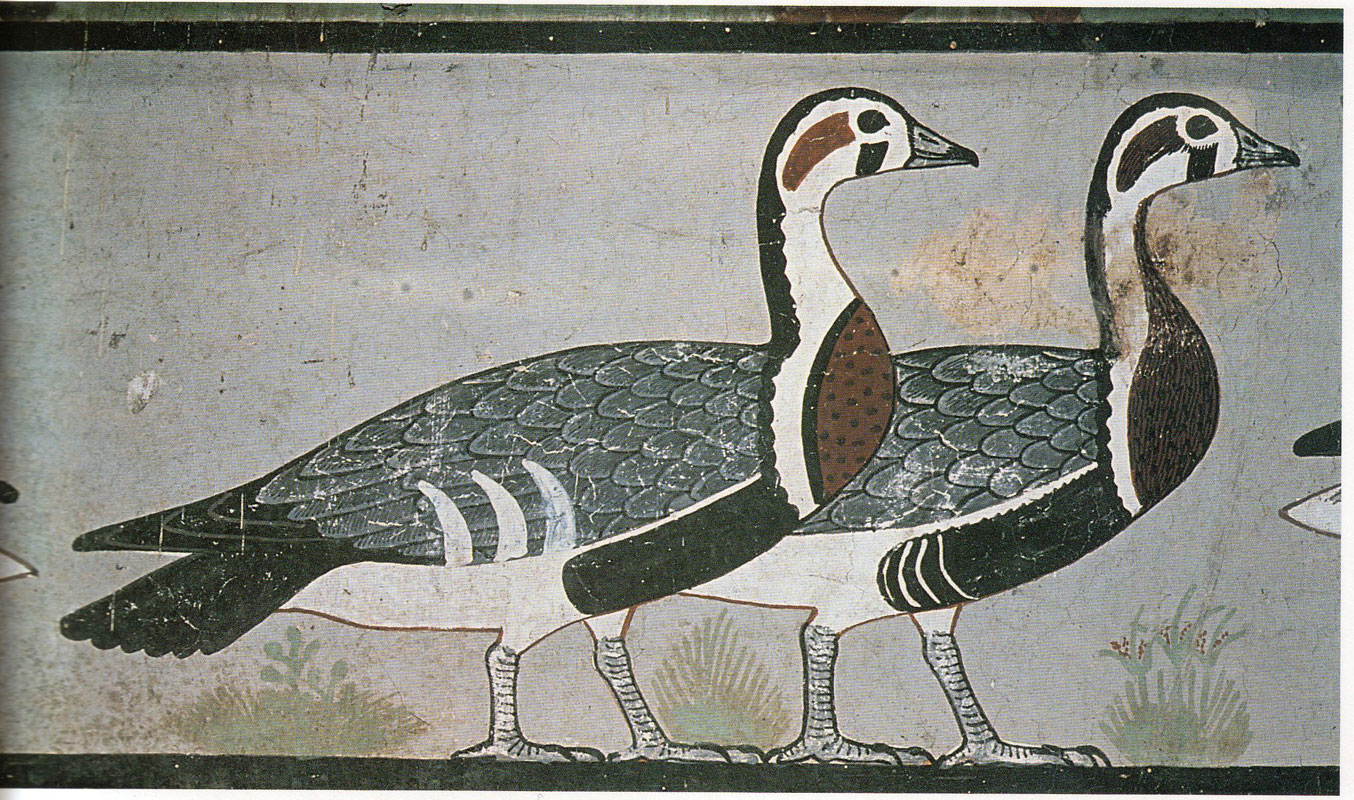
Identification |
|
Title : Geese
Date : ca. 2300 BCE
Medium :
Culture : Old Kingdom Egypt
Significance :
|
| |
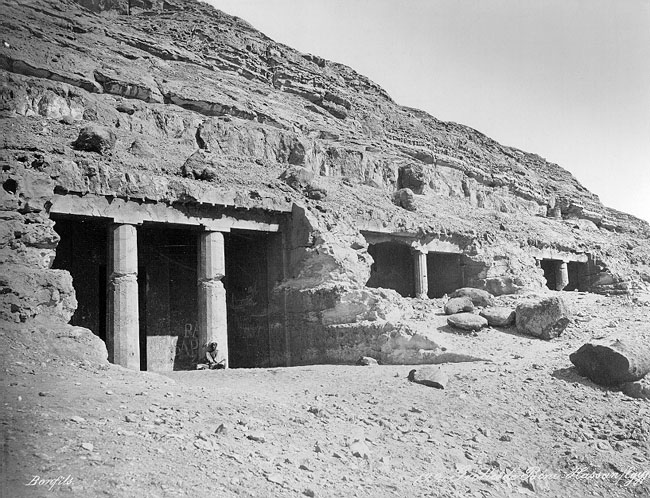
Identification |
|
Title : Rock Cut Tomb
Date : ca. 2040 - 1674 BCE
Medium : Rock
Culture : Middle Kingdom
Significance : Located in Beni Hasan. These tombs contained false doors,
tunnels that changed direction, and blocked passages to deceive
and confuse thieves. |
| |
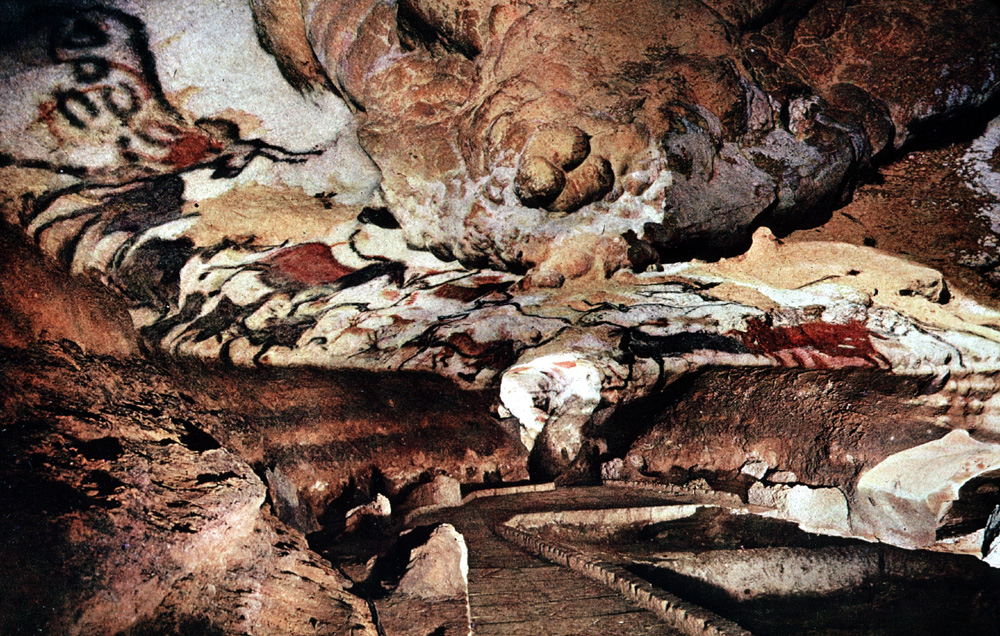
Identification |
|
Title : Hall of Bulls
Date : 15,000 - 12,000 BCE
Medium : Paint on Limestone
Culture : Paleolithic
Significance : Sympathetic magic-connected spirituality to the animal, reenacting the
hunt in the safety of the cave, preparing success for themselves |
| |
Paleolithic Era
|
|
( The Old Stone Age ) Primitive homonid forms existed. Tools were used and temporary
structures created. A Hunter Gatherer Nomadic society. |
| |
|
Neolithic Era |
|
(The New Stone Age) Move from nomadic to agricultural society. |
| |
Megalith
|
|
A large stone |
| |
|
Menhir |
|
A prehistoric monument in the form of a single, large, upright stone |
| |
|
Dolmen |
|
Prehistoric tomb made of large upright stones, capped
with a horizontal stone and originally buried under an earth mound
|
| |
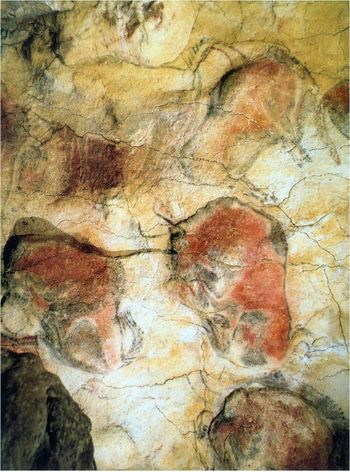
|
|
Title : Altamira Cave Paintings
Date : ca. 12,000 BCE
Medium : paint on limestone
Culture : Paleolithic
Significance : Prehistoric art was first discovered in the Altamira caves.
|
| |
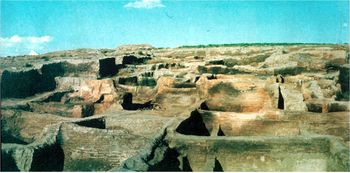
Identification
|
|
-
Catal
Huyuk
- Culture : Neolithic
-
- no
streets or doors
-
openings
in roof provided ventilation and access into interiors
-
houses
were made of mud brick and timber frames
-
walls and
floors plastered and painted
-
houses
served as perimeter wall
-
|
| |

Identification |
|
-
Catal
Huyuk\Neolithic
-
world's
first LANDSCAPE (picture of natural setting in its own right, without
any narrative content)
-
mountain
is thought to be HASAN DAG.
|
| |
|
Relief |
|
A 3 dimensional quality emerging from a flat surface. Comes in low and high depth. |
| |
|
Current authoritative explinations why Paleolithic paintings were
created include: |
|
Purely aesthetic reasons
Shamanistic rituals
Magical influence on reality
Historical record of the hunt |
| |
|
Modeling |
|
Producing a 3 dimensional effect by changes in color, the use of light and shade. |
| |
|
Incising |
|
Carving or engraving into a hard material |
| |
Trilithon
|
|
Two upright stones supporting a third horizontal one. |
| |
|
Cromlech |
|
A circle of large upright megaliths |
| |
|
Alignment |
|
an arrangement in rows |
| |
|
Post-and- lintel |
|
Two upright stones supporting a third horizontal stone |
| |
|
Capstone |
|
Horizontal stone ontop of a post-and-lintel |
| |
|
Canon |
|
A law or rule or standard of art |
| |
|
Palette |
|
a low relief late or slab used for crushing makeup |
| |
|
Register |
|
Horizontal Rows |
| |
|
Stele |
|
Upright stone sometimes decorated. Monumental "pillar" erected to commemorate a historical event |
| |
|
Paleolithic Conventions |
|
Emphasis on animals
Female figure
Limited depictions of humans
No permanent structures
Hand prints |
| |
|
Cuneiform |
|
Earliest known (to date) writing |
| |
|
Cylinder Seal |
|
Means of designating ownership;
practical art form which continues in the Near East for over three
thousand years |
| |
|
Lamassu |
|
An Ancient Near Eastern Guardian of a palace, oten shown in sculpture as a human-headed bull or lion with wings. |
| |
|
Near East Building Material |
|
Mud Brick
Clay was easily found and worked
Hot, dry climate for backing bricks
Stones not always available;trees scarce
|
| |
|
Armana Period |
|
Softer more naturalistic style in the arts
(More Feminine)
Growth in power of the Aten
(creator, creation)
Moved Egyptian capital to Armana or Akhenaten |
| |
|
Hypostyle |
|
Columned hallway |
| |
|
Sphinx |
|
lion's body and head of man |
| |
|
Mastaba |
|
Rectangular bench like egyptian tomb. Limestone blocks built over the shaft of a grave. Maintained the integrity of the body to make an easier transition into the afterlife. |
| |
|
Obelisk |
|
Pillar topped with a Pyramidion. Pyramid on a stick |
| |
|
Step Pyriamd |
|
Burial structure made of several superimposed Mastabas. |
| |
|
Ka |
|
Life force that continues past death;
permitted the deceased to eat and drink offerings |
| |
|
Egyptian Art |
|
For the most part a stable social and religious culture.
Geography of the region enables preservation of items.
Funerary Art produced to ensure a blissful after life. Paintings and sculptures found in these tombs had an eternal purpose.
An art of permanence created mainly for the tombs of the Elite.
Rigidity
Stressed the importance of the afterlife
Importance conveyed by Size
|
| |
Egyptian Tombs Function
|
|
A permanent marker for the living
Indicated the status of the dead
Perpetuated a memory of them
Preservation of the deceased's life force (Ka)
|
| |
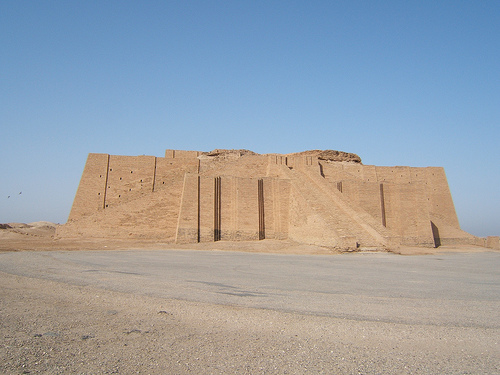
Identification |
|
Title : Ziggurat at Ur
Date : ca. 2100 BCE
Medium : Mud Brick
Culture : Sumerian
Significance : Link between heaven and earth. A place where the priest could commune with god. Dedicated to the moon god.
|
| |

Identification |
|
Title : Warka Vase
Date : 3300 -3000 BCE
Medium : Alabaster
Culture : Sumerian
Significance : One of the earliest examples of a narrative. A Key monument of Sumerian culture. Organized in registers depicting vegetation, animals, bearers of of offerings, and an image of these gifts being offered to the goddess Ishtar.
|
| |
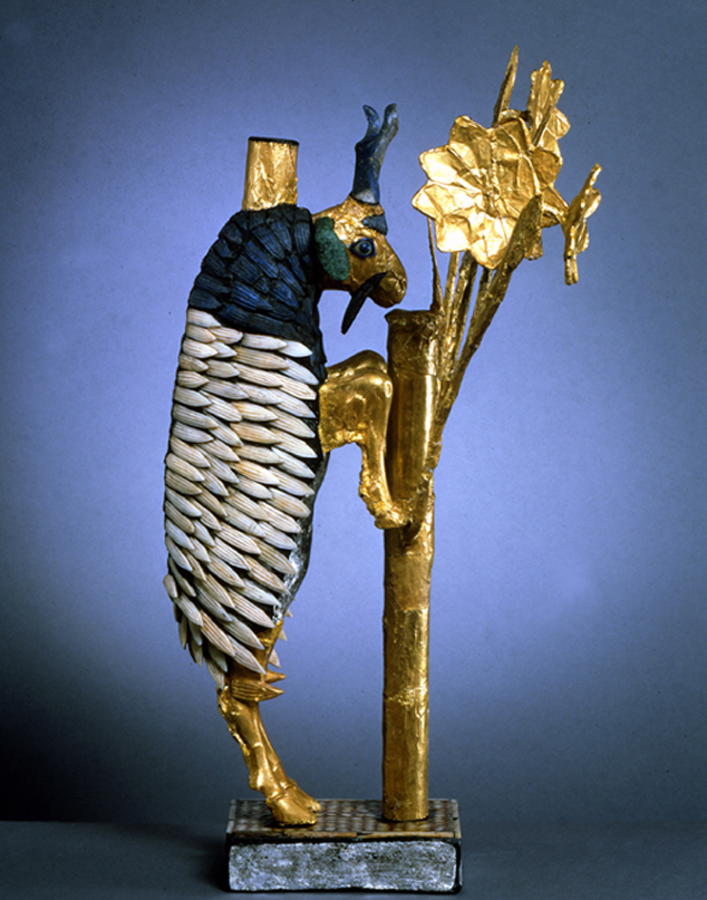
Identification |
|
Title : Ram in a Thicket
Date : 2300 - 2340
Medium : Gold Foil, wood, lapis lazuli
Culture : Sumerian
Significance : Funerary context . Sumerian artists great skill in representing nature.
|
| |
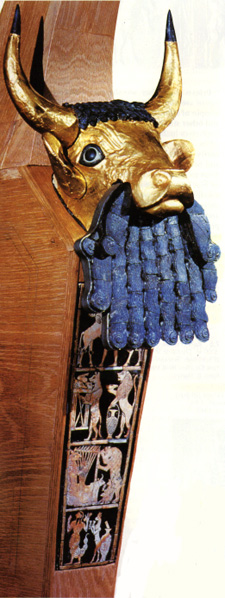
Identification |
|
Title : Soundbox of a harp
Date : ca. 2685 BCE
Medium : Shell and bitumen
Culture : Sumerian
Significance : Music was tremendously important in the Sumerian culture. Depicts animals performing human activities.
|
| |
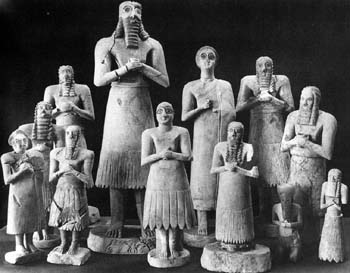
Identification |
|
Title : Figures from Tell Asmar
Date : 2900 - 2600 BCE
Medium : Mostly clay and stone
Culture : Sumerian
Significance : Prayer statues used as substitutions for worshipers. Seeing was a major channel of communication with God. Eyes wide open in admiration to God's awesomeness.
|
| |
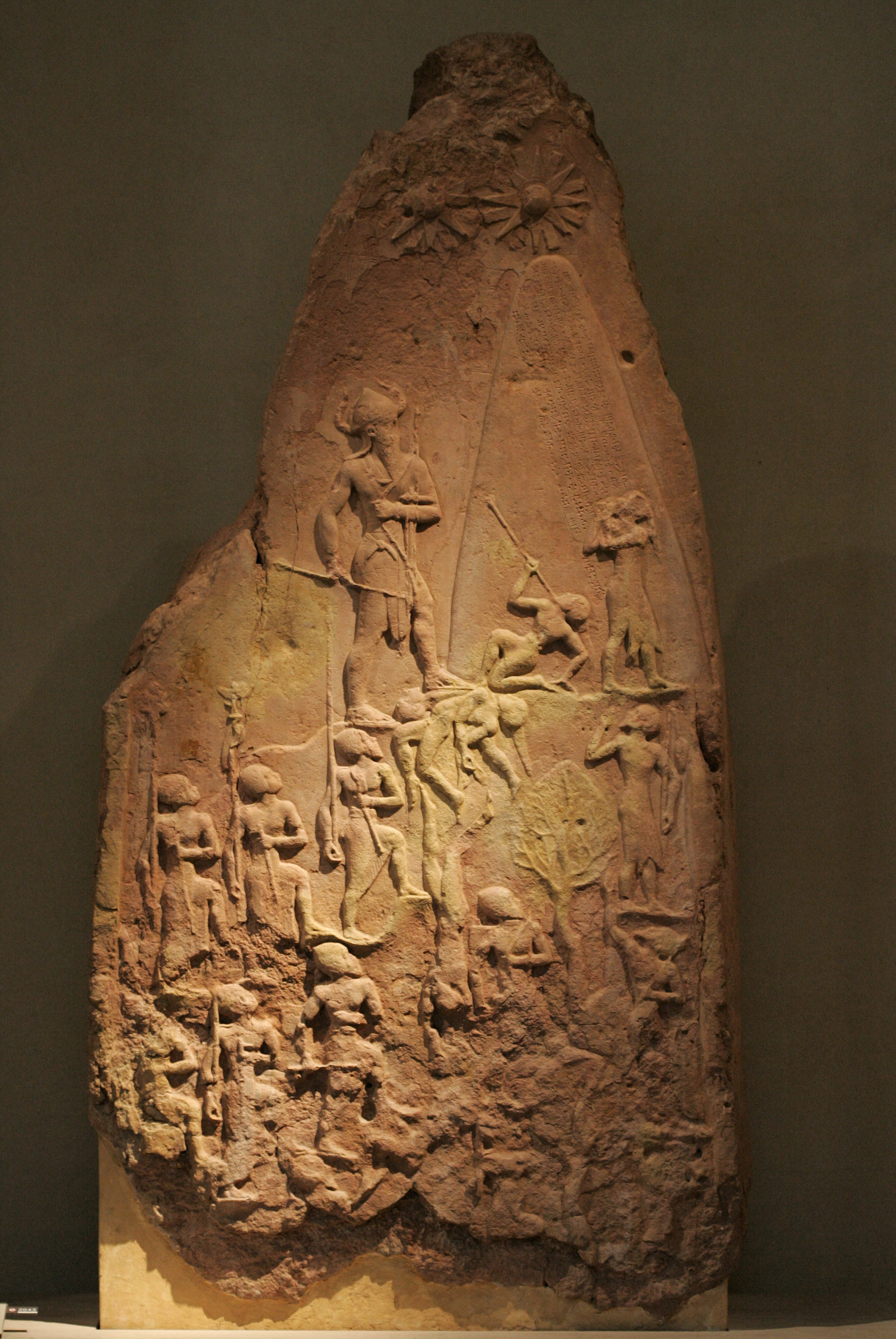
Identification |
|
Title : Stele of Naram Sin
Date : ca. 2254 - 2218 BCE
Medium : Limestone
Culture : Akkadian
Significance : A record of Akkadian invasion and the ascent of Naram Sin to a more divine status.
|
| |
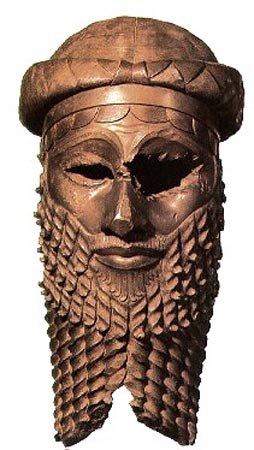
Identification |
|
Title : Head of an Akkadian ruler
Date : ca. 2300 - 2100 BCE
Medium : Bronze
Culture : Akkadian
Significance : Found in a trash heap. Transition from Akkadian rule back to Sumerian rule. Shows Akkadian skill at metal work.
|
| |
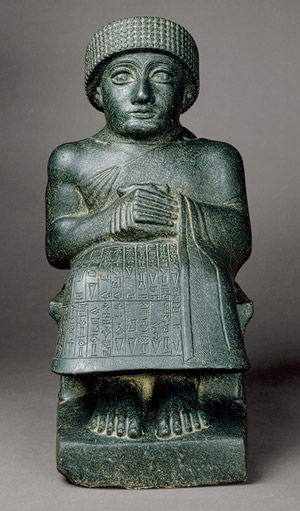
Identification |
|
Title : Seated Gudea / Standing / Head
Date : ca. 2120 BCE
Medium : Diorite
Culture : Neo-Sumerian
Significance : Depicts the king of Lagash doing the traditional job of a King. Praying and communicating to the Gods. Covered in cuneiform script. (A prayer) A mark of his piety.
|
| |
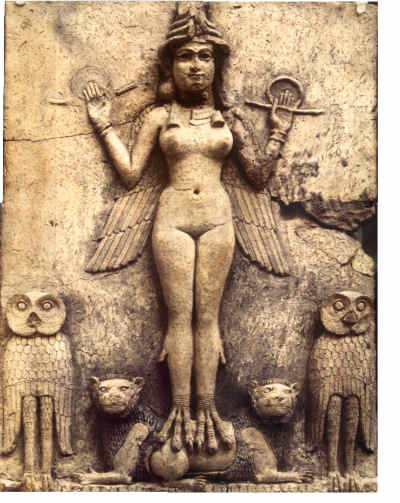
Identification |
|
Title : Lilith
Date : ca, 2025 - 1763
Medium : Terracotta plaque
Culture : Neo-Sumerian/Babylonian
Significance : Depiction of the goddess of the underworld (death, night, and justice after death) Measuring life & value of an individual.
|
| |
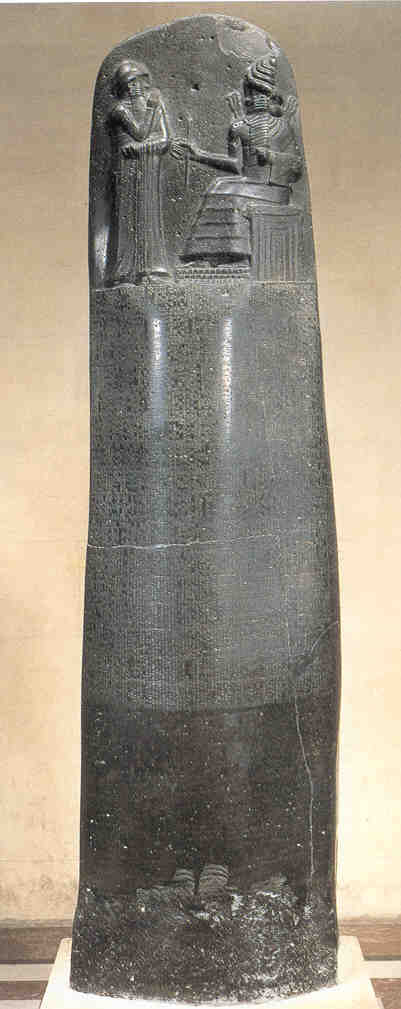
Identification |
|
Title : Stele of Hammurabi
Date : 1792 - 1750 BCE
Medium : Diorite
Culture : Babylonian
Significance : Law codes given to King Hammurabi from the sun god Shamash.
|
| |
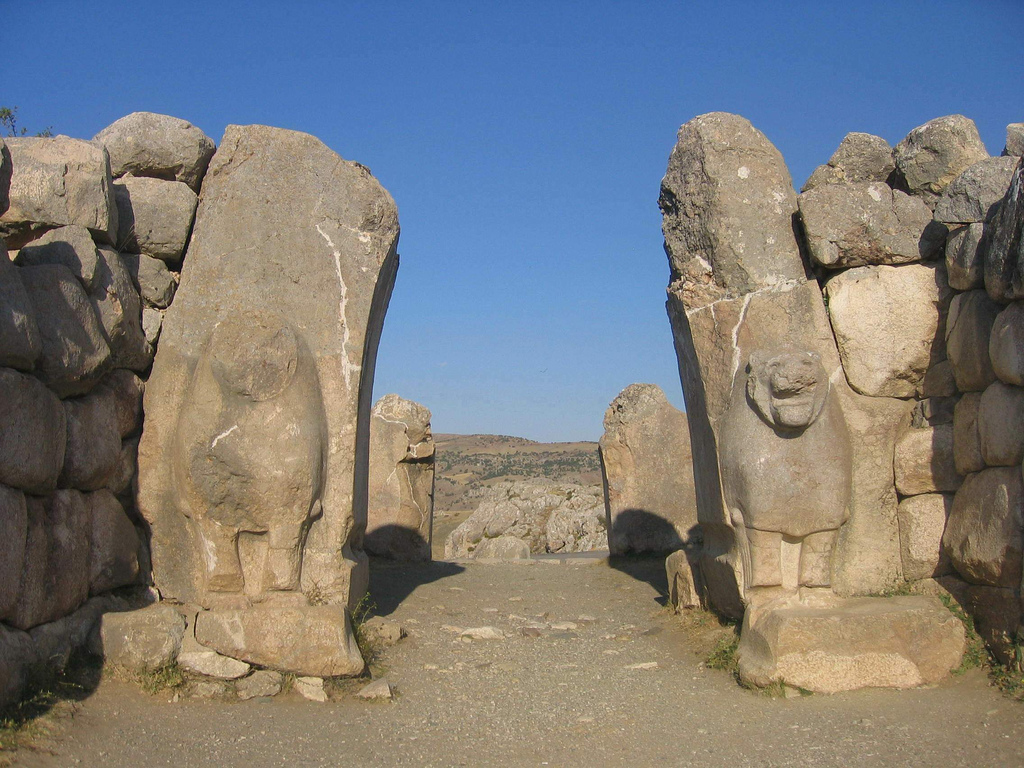
Identification |
|
Title : Lion Gate
Date : ca. 1400 BCE
Medium : Mud Brick / Fire Clay
Culture : Hittites
Significance : Shows the Hittites lack of elegance with stone work as opposed to their skill with metal.
|
| |
|
Pigment |
|
a coloring matter or substance |
| |
|
Prehistoric |
|
Before history. Before writing and record keeping. |
| |
|
Henge |
|
a prehistoric circular area with standing stone |
| |
|
Rock cut Tomb |
|
a burial structure caverns that were tunneled into
natural rock. |
| |
|
Lagash |
|
A City |
| |
|
Rhyton |
|
Elaborate drinking cup |
| |
|
lost-wax casting |
|
steps which are usually used in casting small statues in wax. A Method of duplicating a work by pouring a hardening substance such as wax. |
| |
|
Ziggurat |
|
Large structure made out of baked clay bricks.Resembles a pyramid but terminates to a flat platform at the top. Served as a temple to communicate to God. |
| |
|
Cone Masaic |
|
Repetitive zigzag or lozenge patterns formed by embedding many clay
cones |
| |
|
Pectoral |
|
protective jewelry that hangs down to the chest/breast area |
| |
|
Pylon |
|
A gateway. Monumental entrance to an egyptian temple. |
| |
|
Punt |
|
an ancient Egyptian name of an area not absolutely identified . |
| |
|
Amun |
|
State God. |
| |
|
Mesopapotamian Art |
|
Was Used to effect and reflect political power . To display visual narratives, and to explore story telling through art. |
| |
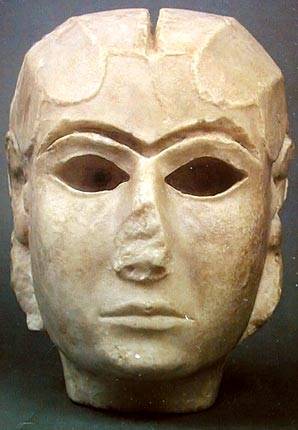
Identification |
|
Title : Female Head
Date : 3500 - 3000 BCE
Medium : Limestone
Culture : Sumerian
Significance : A cult statue found in the Eanna Sanctuary of Inanna (Goddess of Love and War)
|
| |
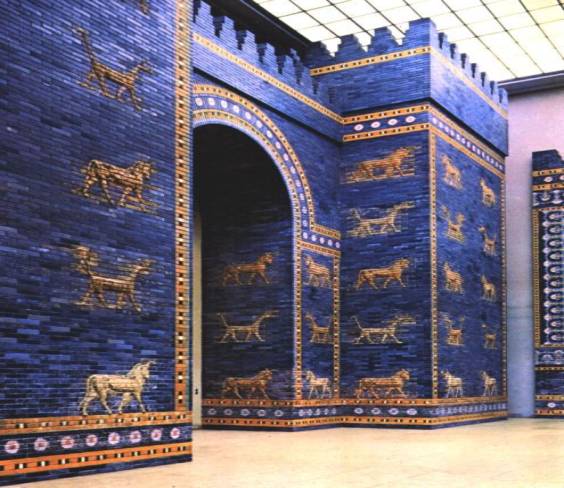
Identification |
|
Title : Ishtar Gate
Date : ca. 575 BCE
Medium : Glazed Brick
Culture : Neo-Babylonian
Significance : The vivid coloristic effect of glazed brick. Named after the goddess of love and war
|
| |
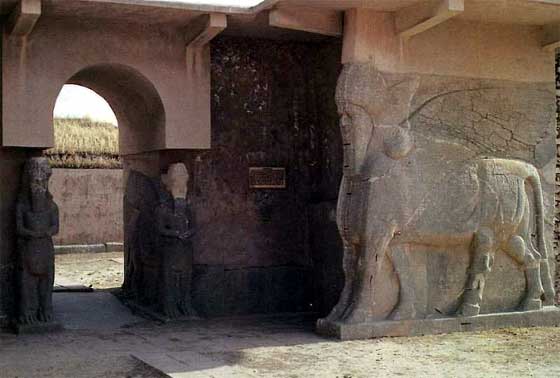
Identification |
|
Title : Nimrud palace of Assurnasirpal
Date: ca 850 BCE
Medium : Architecture
Culture : Assyrian
Significance :
|
| |
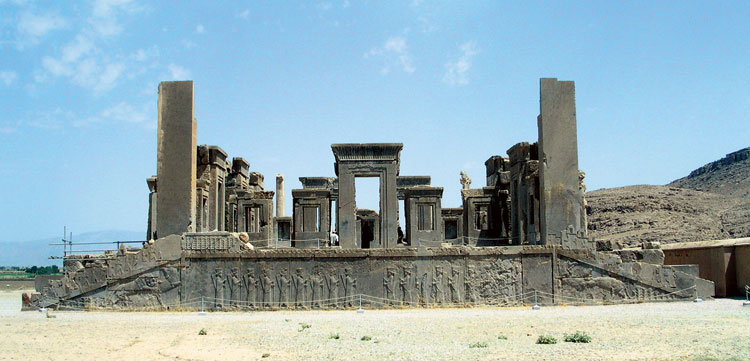
Identification |
|
Title : Palace of Darius
Date : 518 - 460 BCE
Medium : Architecture
Culture : Persian
Significance :
|
| |
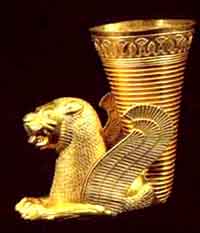
Identification |
|
Title : Lion Head Rhyton
Date : ca 550 - 450 BCE
Medium : Gold
Culture : Persian
Significance :
|
| |
|
Three Statues of Hatshepsut |
|
Date : ca 1473-1458 BCE
Culture : New Kingdom
Significance : Female Queen depicted more masculine
|
| |
|
Mortuary Temple of Hatshepsut |
|
Date : 1473 -1458 BCE
Culture : New Kingdom
|
| |
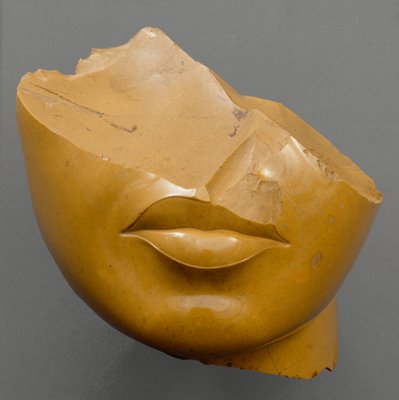
Identification |
|
Title : Face of a Queen
Date : 1352-1336 BCE
Medium : Yellow Jasper
Culture : New Kingdom
|
| |
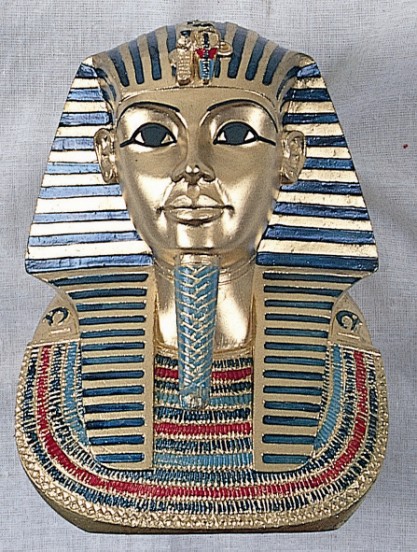
Identification |
|
Title : Funerary Mask of Tutankhamun
Date : ca. 1327
Medium : Gold inlaid with glass and semiprecious stones
Culture : New Kingdom
Significance : Most of the tomb and its treasures remained intact which is unusual because tombs were robbed frequently.
|
| |
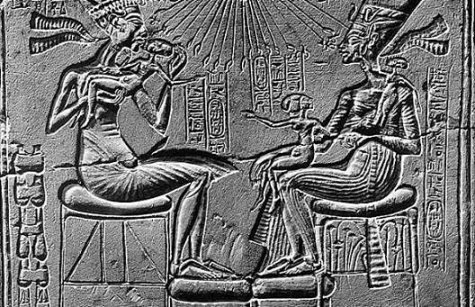
Identification |
|
Title : Stela Depicting the Royal Family
Date : ca. 1352 -1336 BCE
Medium : Painted Limestone
Culture : New Kingdom
Significance : depiction of a loving family.
|
| |
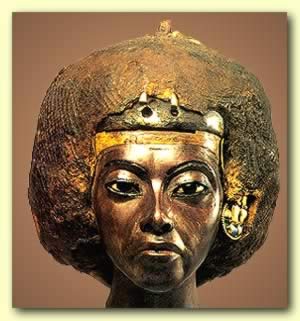
Identification |
|
Title : Head of Queen Tiy
Date : ca. 1352 BCE
Medium : Gold , Clay , boxwood
Culture : New Kingdom
|
| |
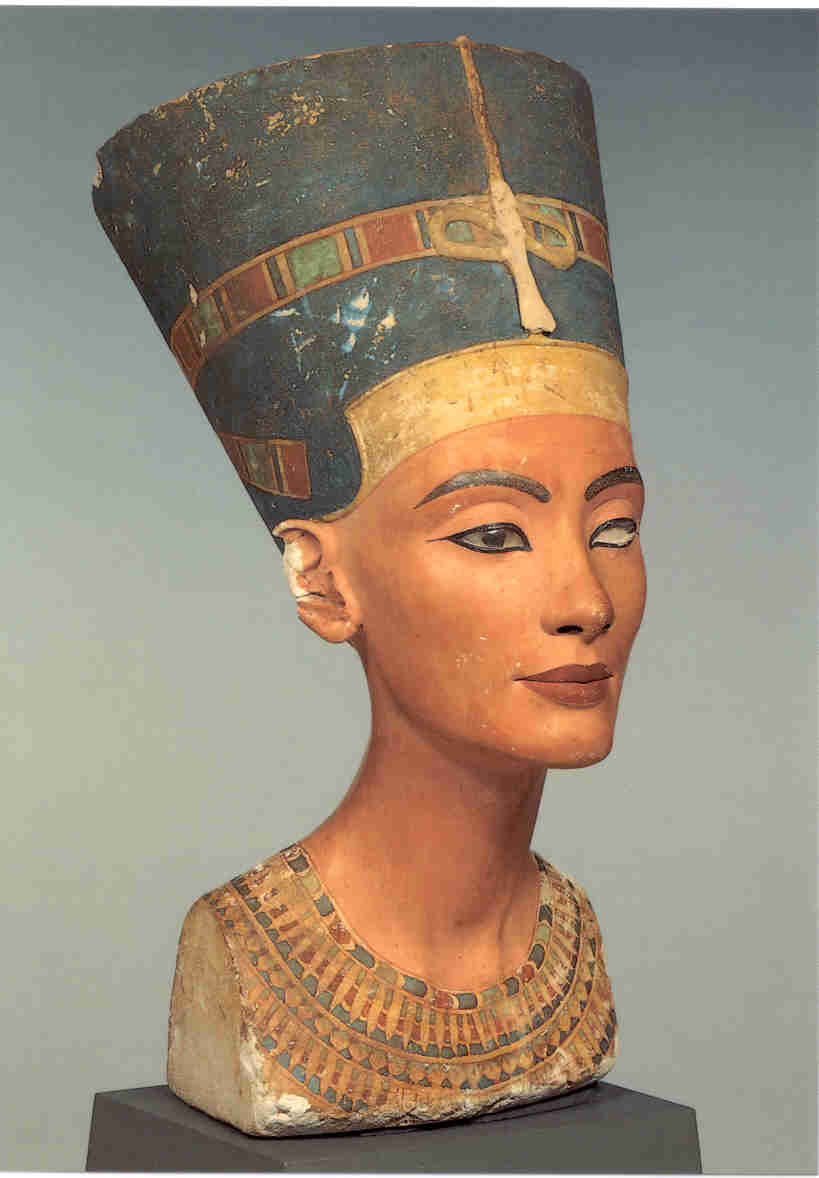
Identification |
|
Title : Bust of Queen Nefertiti
Date : ca. 1352 - 1336
Medium : Painted Limestone
Culture : New Kingdom
Significance : Possibly a naturalistic depiction of the Queen but there's another bust of a much older woman beneath it.
|
| |
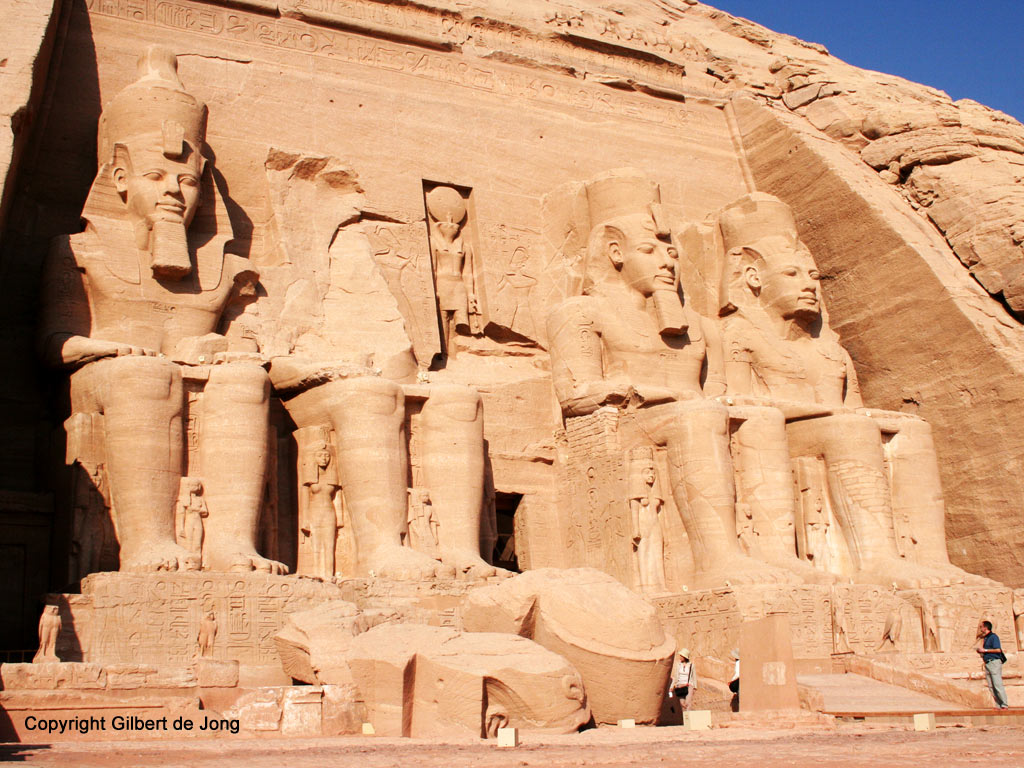
Identification |
|
Title : Abu Simbel
Date : ca. 1279 - 1213 BCE
Medium : rock
Culture : New Kingdom
Significance : massive rock temples built by Ramses.
|
| |
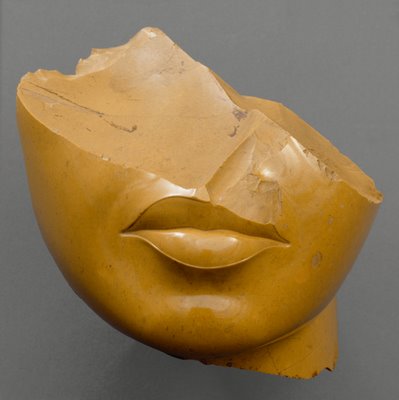
Identification |
|
Title : Face of a Queen
Date : 1352 - 1336 BCE
Medium : Yellow Jasper
Culture : New Kingdom
Significance : From a statue composed of many different materials.
|
| |

Identification |
|
Title : Colossoal Statue of Akhenaten
Date : ca. 1352 -1336 BCE
Medium : Sandstone
Culture : New Kingdom
Significance : Akhenaten's worship of the Aten god of creation and sun influencing the art work to be more feminized/ naturalistic.
|
| |
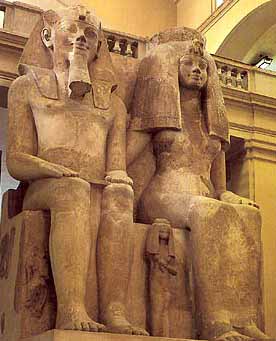
Identification |
|
Title : Colossal Statue of Amenhotep III and Queen Tiy
Date : ca. 1390 - 1352 BCE
Culture : New Kingdom
|
| |
|
Neolithic Time Period? |
|
8000 - 2300 BCE |
| |
|
Paleolithic Time Period? |
|
40,000 - 8000 BCE |
| |
|
Predynastic Egypt Time Period? |
|
before ca. 3150 BCE |
| |
|
Early Dynastic Egypt Time Period? |
|
ca. 3150 -2575 BCE |
| |
|
Old Kingdom Egypt Time Period? |
|
ca. 2700 - 2150 BCE |
| |
|
Middle Kingdom Egypt Time Period? |
|
ca. 2040 - 1674 BCE |
| |
|
Sumerian Art Time Period |
|
ca. 3500 - 2300 BCE |
| |
|
Akkadian Art Time Period? |
|
ca. 2300 - 2100 BCE |
| |
|
Neo-Sumerian and Babylonian Art Time Period ? |
|
ca. 1792 - 1700 BCE |
| |
|
Hittites Time Period? |
|
ca. 1600 -1300 BCE |
| |
|
Assyrian Art |
|
ca. 1000 - 615 BCE |
| |
|
Neo-Babylonian Art |
|
ca. 612 - 539 BCE |
| |
|
Persian Art |
|
ca. 539 -331 BCE |
| |
|
New Kingdom Art |
|
ca. 1550 - 1069 BCE |
| |
